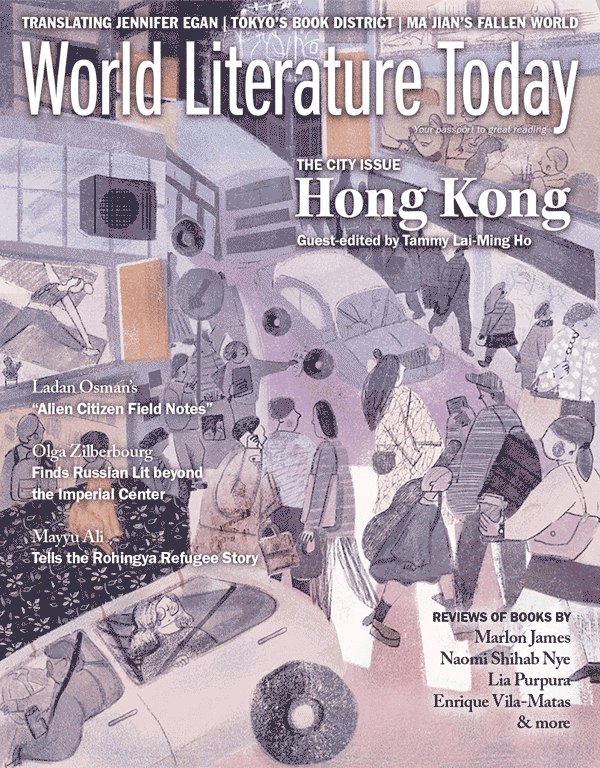Landscape Vertigo
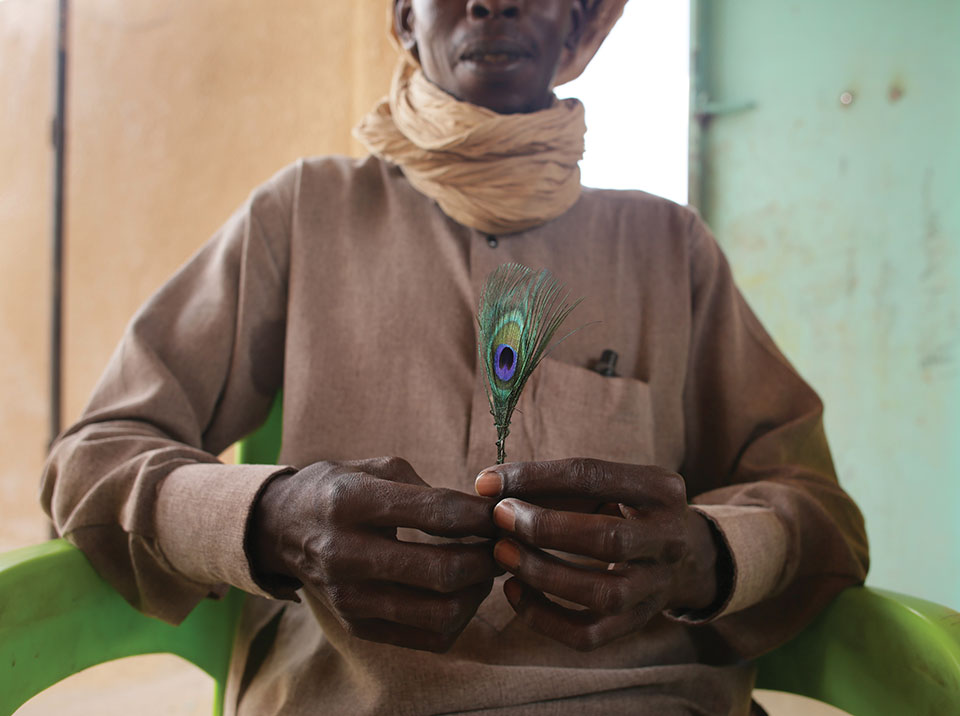
Traveling on to Dirkou, long a respite town on the desert road to and from Libya, and then to Bilma, Ladan Osman encounters soldiers, civilians, and community leaders as she continues to document the migrant landscape.
The hotel in Niamey is intensely private. Its lobby large and almost silent, with armchairs so plush they take on a presence. Trays stacked with dishes set outside doors are the clearest evidence of occupants until dinner hours, when there are murmured exchanges over meals in the dimmed courtyard. A concierge glides with precision at regular intervals. When he takes a break, he leans against a tall corridor window and stares over the lush property. The Niger River is visible, the morning air green-scented, but knowledge of armed guards strolling the grounds discourages me from stepping off the patio. One afternoon, I chat in staggering French with an employee who has knocked on the door in friendship, she says. I initially assume I’m in trouble. She reacts as if she’s offended me. My attempts at pleasantries hobble, but she’s patient. And why would I be in trouble?
I vision myself wearing a gown with an endless train, this bolt of fabric long enough to stretch across the Atlantic. I drag it and wring it out.
I’ve dragged along a hastily packed garbage bag of reference points: assumptions that I’m not welcome, that an accusation and its consequence await me, that I’m unsafe as an actor inside history and as a recipient of it. I think of James Baldwin in 1984,1 lunching outside his villa in St. Paul de Vence, saying: Given the conditions in this country to be a black writer was impossible. This country, not meaning France but the United States, the nation whose subsumption he describes in the language of submersion: If I had stayed there, I would have gone under. During the summer and fall of 2018, I visit five countries. I say: here not: there when talking about home. My partner, more practiced in moving his tethers, then takes a beat and says: You mean: America? I vision myself wearing a gown with an endless train, this bolt of fabric long enough to stretch across the Atlantic. I drag it and wring it out. I face it and strain as I pull, as I gather it to me, my back turned to where I’m actually standing.
I’m unsafe as an actor inside history and as a recipient of it. I think of James Baldwin saying: Given the conditions in this country to be a black writer was impossible.
While the journalists plan travel to Dirkou, which has long been a respite town on the desert road to and from Libya, I marvel at their focus, their ability to process and condense data around a particular intention. They work to gather information then share it in a tight time frame with the aim of encouraging attentiveness from both the casual reader and the one that may impact policy in response to a narrative. There’s a more direct line between effort and its impacts. They’ve revealed conditions and decisions within systems that thrive under opacity. They’ve answered to officials for what they’ve printed. Most of my own writing accrues meaning and contexts once published, permission retroactive. My research is seemingly unofficial, a long tourism of subjects in which I have no degree or job letter. I’m still reeling from our conversations with travel-weary people in between long bus rides across multiple borders. How do you keep yourself together? I ask. They say they don’t, exactly; that it’s easy to burn out, hard to tell when sensitivity is eroded.
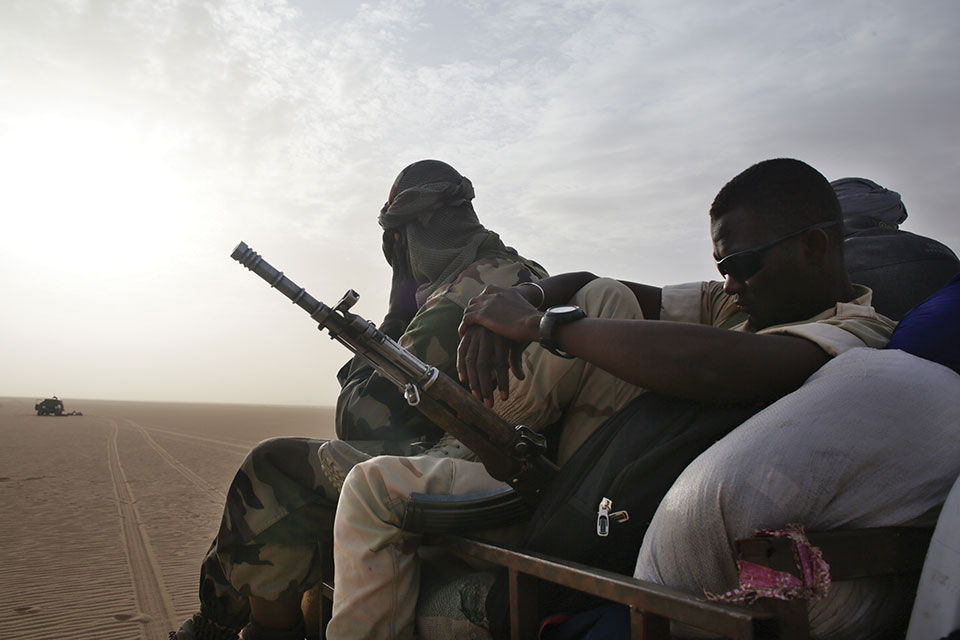
I review precautions and pack a small mirror in case we must signal for help, a superficial gesture to a landscape that forces submission.
We take a commercial flight operated by Niger Airlines, only the second to Dirkou. The other passengers are Niger Airlines officials perfecting logistics. There’s one flight every two weeks, and it can be rescheduled at the last minute. We’ve planned for the possibility of driving to Agadez, a two-day trip difficult even for those who know it well. I review precautions and pack a small mirror in case we must signal for help, a superficial gesture to a landscape that forces submission. As we descend, the sand so imposing it abstracts the view and the plane’s movements, I tamp the mild panic of being so far from land organized in a way I understand. It’s similar to my discomfort in any town: slight vertigo from my unfamiliarity with a geography, a sky and its particular blue. The mayor of Dirkou waits on the airstrip. He entrusts us to the vice mayor, who entrusts us to his chauffeur. Because my aims are less concrete and because it’s easy to remain silent when unaddressed, I zoom out and watch assertions of preferred realities. More often than not, government officials, former drivers (now termed “human smugglers”), merchants, and residents grant interviews. Besides the exhaustive labor it takes to gain confidence in a region, I’m impressed by how all kinds of people make themselves available to participate in story-shaping.
For authority figures and their press officers, there’s usually little ambivalence, their priorities obvious, their cordiality calculated and retrievable. I didn’t know before now that myth-making and nation-building also happen in real time, structures and borders erected with each documentation of a place and its government. I consider the reach of Western journalism, how wire agencies and big publications might have acquired power. The potential for colonization of narrative reconstructs a memory: a model of the Santa María on the Scioto River in Columbus, Ohio. My teenaged self reenters the scene, sniffs the ship’s rot. The art of naming, registering, and distributing what is happening must take such discipline. For careful journalists, it may be nearly impossible to distinguish between what the main current wants and what the story itself requires. Something we call truth but may be closer to possibility.
The afternoons are intended for rest, long breaks between site visits, reassembly scheduled after the sun’s retreat. Instead of napping, the journalists make calls, discuss interview approaches, review and transcribe notes, confer with editors. The mayor has invited us to stay in his home, its courtyards, small farm, and extra rooms stuffy from disuse allowing space to pace, smoke, chat with the property’s caretakers. At night, they watch Indian soap operas outdoors via satellite, their relaxation after a late dinner, after a final confirmation that we’re settled for the night, which is absolute, dense, a sequences of veils one must lift every few paces. As we sleep, the mayor’s peacock walks on the corrugated roof of an adjoining building. The metal under its claws sounds as if it’s being sheared, and until air-conditioning makes its way around the room, the day’s heat is like a fevered child sleeping on my back. In the late evening, we’d observed drones overhead. Those motors whirr with the persistence of mosquitoes, an unanticipated presence in Dirkou, and by morning we wake unsettled, the light red as it hits heavy velveteen drapes.
Our early meetings are with military and police officers. One commander is fragrant, like each part of his uniform has been held over perfumed smoke, his carriage similar to a bounce house, his skin smooth with good nutrition. The bottled water he offers us somehow tastes like incense. He presents an informative slideshow on how the military deters migrants in the region, a fluorescent light flickering just as he starts. The maps of migration routes and potential minefields intersect, and he’s careful to describe humanitarian concerns alongside security objectives. In 2015 up to seven thousand people passed through Niger to Libya every week, that number now reduced to about one thousand. In the town of several thousand, he says there are 191 migrants, most of whom will return home to Nigeria, Guinea, Ivory Coast, and Burkina Faso with the International Organization for Migration’s assistance. When asked about deaths in the desert, he admits a majority of deaths cannot be seen or counted, that it’s impossible to retrieve many of those bodies. One journalist asks about deaths at the hands of the police, and he scrolls to a slide on migrants caught with drugs or explosives. He describes how Daesh has changed its methods to influence youth and outlines the pathways of Algerian pharmaceuticals, Moroccan hash, and cocaine, which fund “narco terrorism.” It appears the Nigerien military is responsible for managing hyperlocal issues that have international reverberations, the diplomatic negotiations between French, American, and neighboring militaries delicate, their activities with police obscured from the public. Jurisdiction blurs as people are defined by their circumstances rather than their citizenship, and by how their motions affect national or European concerns. Patrolling a landscape that’s ultimately unconquerable is costly, timely, each patrol requiring stunning amounts of gasoline, water, replacement tires, and manpower. Nigerien officials acknowledge that migration is a welcome and long tradition and also note that the nature of the enemy has changed. A senior official asks: How do you define instability when it’s widespread?
Jurisdiction blurs as people are defined by their circumstances rather than their citizenship, and by how their motions affect national or European concerns.
Before we leave, we take a tour of the impound lot on the military base. Here are rows of single-cab Toyota Hilux trucks, their tires deflated or rims resting on rocks, their bodies displaying evidence of crashes. The sun climbs, uncompromising as we walk between vehicles, free to peer at the detritus on the seats and flatbeds: a high-top sneaker, notebooks full of names and numbers, a tattered travel document, broken glass and brake light covers, underwear and shawls, bowls and plastic cups. In one driver’s seat, a tire is positioned behind the steering wheel. The passenger seat is folded down, bowing to the dashboard, the interior covered in tawny dust. A collection of successes for the military and police represents incalculable loss for travelers and the people they’ve paid to handle their transit. These seizures may have prevented tormented deaths in the Sahara, may have interrupted the sale of drugs or weapons, but they largely represent lost savings, scattered plans, and wrecked ambitions. The lot requires the solemnity of a graveyard, and prompts similarly quickened exits because acknowledgment of one’s own mobility is clarified by others’ demises. A nod, a pause, then a chastened return to one’s own life.
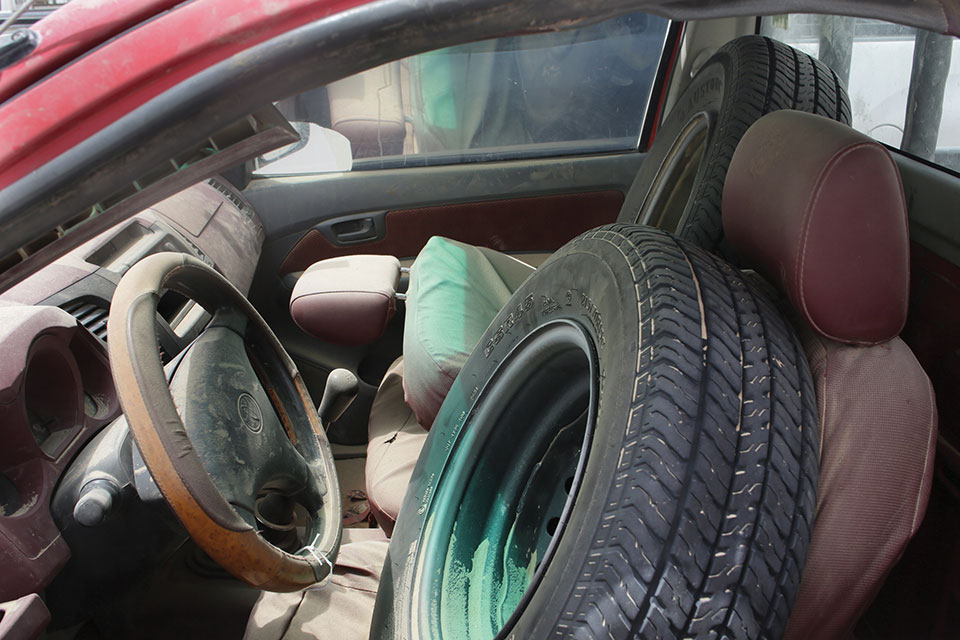
We walk between vehicles, free to peer at the detritus on the seats and flatbeds: a high-top sneaker, notebooks full of names and numbers, a tattered travel document, broken glass and brake light covers, underwear and shawls, bowls and plastic cups.
Later on, Dirkou’s police commander claims that many drivers, whom he calls smugglers, armed themselves after 2017. He sits in a dim room behind an empty desk, his computer monitor covered, wearing a pressed green uniform with no markings. He gestures with a ruler, and his demeanor shows me that authorities can make anyone feel guilty, involved. Most of the drivers we meet over that week say their livelihoods have been destroyed. In more drastic conditions, they drove overcrowded trucks sightless, at top speed, with their heads stuck out the window to gain spatial awareness. Some used to own several vehicles and made seven to eight million CFA (US$12,000–14,000) per month; now they struggle to buy basic goods to feed their families. They say the police beat them, then remove their carburetors. They recall this with a pang, as if discussing an organ. The police claim they use minimal force and are vague if asked about the treatment of detainees. When we visit the local jail, a man shows us his burned hands, covered with a gummy substance. Some drivers readily accept that they’ve committed a crime under new antimigration laws but emphasize that their families include generations of drivers, and what profession could they now master? The pressure on Dirkou as it performs as a hinge between Agadez and Libya stresses the crux. The police commander makes a seesaw motion with his ruler and suggests we travel with the big guns, saying it’s a problem for him and for Niger if we’re kidnapped.
Conversations in neighborhoods around town are limited, probably in part because an armed guard is assigned to escort us. We talk to residents who opted to stay in Dirkou, sometimes due to fatigue, with the conviction that home held nothing for them. In the undercurrent, another answer not given as eyes flit to the bored guard: there may be an opportunity to try their journeys again. We meet very few women, and they’re reluctant to detail their necessarily different experiences on the road. A representative of an NGO dealing with gender-based violence informs us that both migrants and locals abuse traveling women, that they’re subjected to harm every step of the way. In contrast to men and boys, they say they were enslaved in Libya, sold for domestic labor but often used for sex. Two Nigerian women operate a small bar, the outer walls strung with colorful cans. They appear only a little more comfortable talking to me, touching the back of my hand as they speak. It’s a dialogue of desires and disappointments, one that struggles to eschew shame. Like the mothers I met in Niamey the week before, they say they left with the promise of housework. Rather than revisit the reality, they share the sums that bought their freedom, amounts that took years to save. Not far from their bar, a group of women live together, their shared homes clustered around a small well. They agree to various appointments so we can interview them with proper notice but are gone when we return, their slippers or still-dripping wash the only proof we didn’t imagine them there.
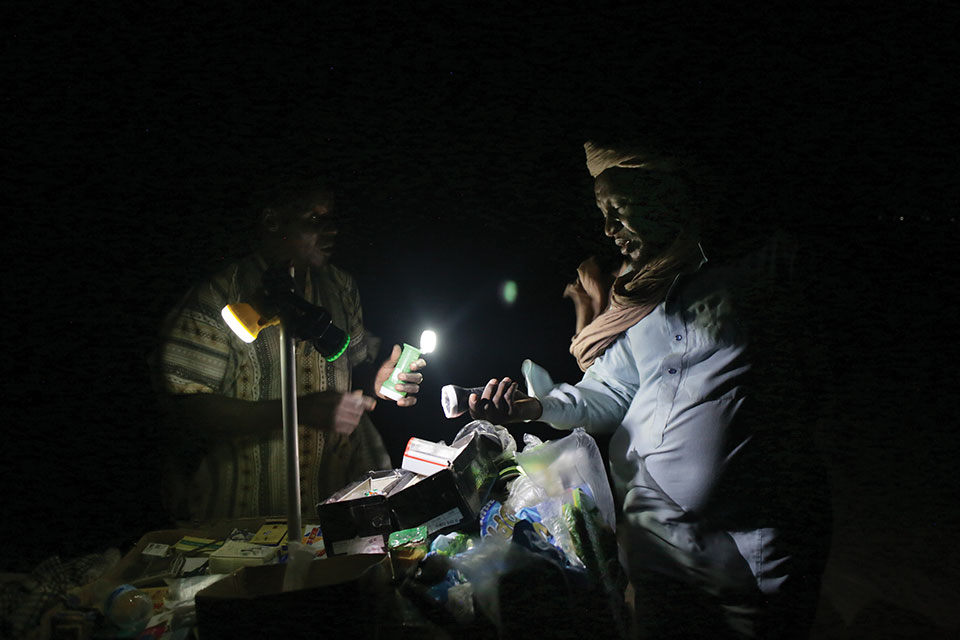
I’m overused to male voices by now. When we visit offices and homes, we catch glimpses of a woman in the corridor, a woman and her children sitting in a courtyard. These absences and unknown presences disturb me, but I don’t want to assume their statuses, to become a Western stereotype. Once or twice officials demonstrate glaring gender bias, so I describe their outfits and demeanors in my notebook, mark their quotes: redacted. I take creepshots and label them: men talking to each other. I imagine them self-installing in a museum, alongside their oversized chairs and polished desks that don’t see concentrated work. How to respond to maleness attempting engulfment, especially from the sidelines? My partner reaches across the rift; fails, tries again. The most consistent comfort is his effort. My frustrations become keen examinations of his inclinations, our workability. I rage-cry at night, cooling my face in forgiving breezes, gasping alone at twilight with no fear because I’m a stranger anyway, my behavior alien. A femme punk certain the scorpions won’t bite, the dark mine and, for me, my hand in the air when a rare desert rain falls, the others asleep.
We visit the oasis town of Bilma about forty kilometers away, riding into our first taste of the dunes. We tour ancient wells, pools fed by aquifers, and a date grove. The doorways that lead to sky via open-air squares are so like Pina Bausch’s staging, I expect a dancer in a billowing dress straining against a tether, another carrying a small tree on her back. I’m uneasy with what officials and bystanders have divulged in recent days: allegations that the French army exercises a fake cinema so they can store equipment (like people who move into a neighborhood at dawn, their nicer things hidden by ratty blankets or boxes); a video of the French not assisting Nigerien troops during an attack; payoffs to militia groups to keep migrants from reaching Europe; foreign military interventions at the Libyan border and an undeclared drone presence. In Bilma, we meet with an extremely chill community religious leader and craftsmen who cultivate the salt that nourishes livestock across the region. Security issues and resulting instability, compounded by the effects of climate change, devastate the salt trade. Despite this, it’s a sleepy reprieve from sit-downs with soldiers and ministers. As we go, I notice fleur-de-lis on an iron gate and am again amazed that France is here, too.
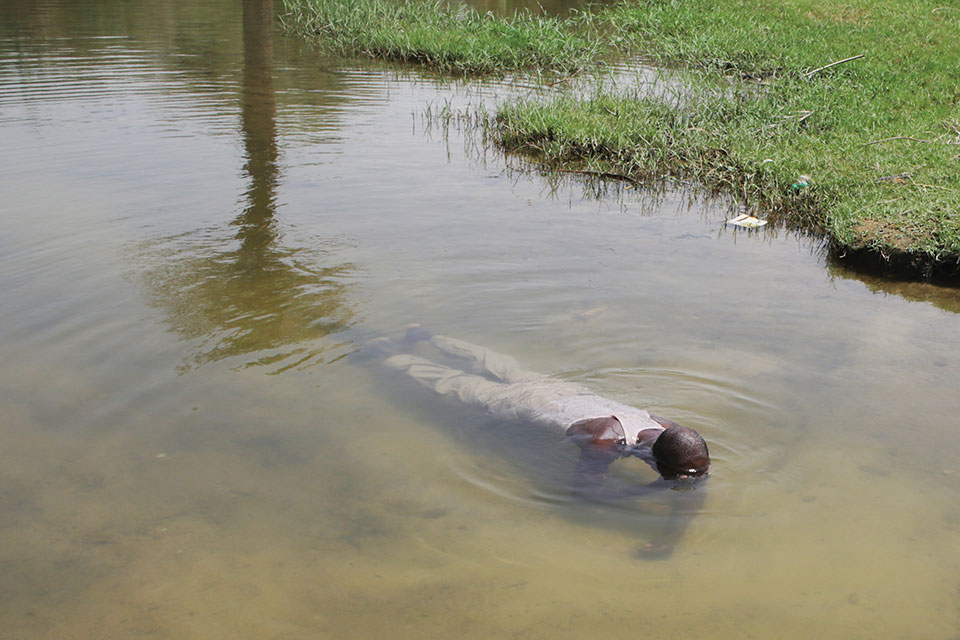
The flight is rescheduled but we decide to drive rather than wait another week. The vice mayor’s chauffeur, a former transporter, agrees to take us to Agadez. Although the prescient static of trouble crackles off a senior military official, he remains jovial. One evening, I watched a man run to do his bidding, and have become nervous around him. He links us with a caravan of fifteen or so vehicles and orders a protective lead for the last leg of our trip. All the vehicles idle near sunset, a mix of civilian, military, and NGO activities. This five-hundred-kilometer journey requires an experienced driver and mechanic, a substitute driver, enough water and gas to last through the drivers’ return, and a satellite phone. Even with escorts, people grimace as they warn us, the most repeated worries breakdowns and bandits. The three of us sit in the back, meeting eyes with soldiers and civilians who travel riding in truck beds. In one truck, several women lie flat among their chickens.
The first hours are not unlike our visits to surrounding towns. It’s not until we stop for dinner and a brief sleep that the extremes of the landscape are explicit. The night creates pockets into which I can disappear, a woman made from dark matter. I stretch, squat behind a small rock pile, take photos of soldiers as they set up a contraption, and, unbelievably, begin to pulse signals in Morse code with the aid of a long antenna. The terrain is punctuated with the skeletons of people, animals, and cars, the stubborn metal most glaring. On our first day, we were told lost migrants are located by people familiar with the desert. They share wind direction, the amount of red in the sand, and are found.














